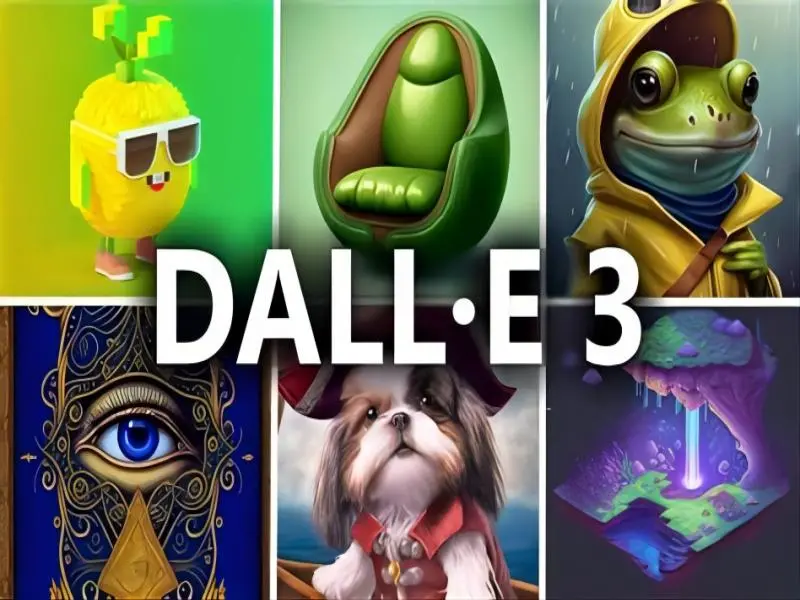- DALL-E 3 is an incredible tool for visual brainstorming and concept generation for designers.
- DALL-E 3 is used through ChatGPT, it’s more important than ever to understand how your words help these tools generate outputs.
- DALL-E 3 (along with all generative AI) use comes with several ethical concerns since the capabilities of most are built on the backs of hardworking artists who never permitted their work to be used in training.
The world of artificial intelligence (AI) has been abuzz with advancements in generative models, particularly in the field of image generation. One of the most significant developments in this arena is the emergence of DALL-E 3, an AI-driven image generator that is reshaping the way we perceive and create visual content. In this blog post, we will delve into the intricacies of DALL-E 3, its capabilities, and the profound impact it is having on the realms of art, design, and beyond.
The DALL-E 3 phenomenon
DALL-E 3, developed by OpenAI, is the successor to the original DALL-E model, which was inspired by the surrealist artist Salvador Dalí and the Pixar character WALL-E. Unlike its predecessor, DALL-E 3 has taken the concept of generative AI to new heights, offering an unprecedented level of detail and control over the generated images.
Also read: Demis Hassabis: Co-founder of DeepMind was a child chess prodigy, then AI pioneer
Capabilities and features
High-resolution image generation: DALL-E 3 is capable of producing images at a resolution that rivals human-created artwork. This leap in quality opens up new possibilities for digital artists and designers.
Text-to-image synthesis: Users can describe a scene, an object, or a concept in text, and DALL-E 3 will generate an image that encapsulates that description. This feature has profound implications for accessibility in art and design.
Control over attributes: DALL-E 3 allows users to specify certain attributes of the generated images, such as the style, mood, or even the lighting conditions. This level of control is a game-changer for personalised content creation.
Edits and iterations: The model can take an existing image and apply edits or variations based on user input. This iterative process can lead to the creation of unique and refined visual content.
Multi-modal outputs: DALL-E 3 can generate images that combine different concepts, styles, and elements, creating a multi-modal output that was previously unimaginable.
How to use DALL-E 3 image generator?
Sign up and pay up
Start with an account for the standard ChatGPT. If you don’t have one, use an Apple, Google, or Microsoft account, or create a login with an email address and a strong password. There’s no multifactor authentication option at this stage.
Once you’re in, you’ll see Upgrade Plan at the lower left, or the menu at the top that says ChatGPT 3.5, which offers a choice to switch to GPT-4/Upgrade to Plus. Either will show this screen, with the Upgrade to Plus option.
Prep for the chat
Unlike the DALL-E 2, which had its interface, DALL-E 3 is just another aspect of ChatGPT 4, where you send a “message” and the chatbot responds. Thankfully, with GPT-4 you can have an ongoing conversation to change/adapt/improve the things it generates for you. That includes images. On the premium ChatGPT Plus, prompts are limited to 4,000 characters—approximately 500 words.
The perfect prompt
Design prompts have both content subject terms (what you want to see) and style modifiers (how it should look). For example: “A robot drawing a painting at an easel” is content, but “over-the-shoulder view, colourful, oil paint, in the style of Van Gogh” are all modifiers. You can also use several other modifiers to boost quality, focus DALL-E on particular things, or just insert some extra creativity. Use emotional words to get a more positive or negative image and set the mood or aesthetic.
Also read: What is Perplexity AI?
Changing sizes and retaining styles
With DALL-E 3, you only get one image per prompt by default. However, you can specify that it generates as many as 10 from one prompt. Or you can enter multiple unique prompts in the chat to receive multiple images, each one exclusive to its prompt, not all variations on the same wording.
Images from DALL-E arrive by default in a square measuring 1024×1024 pixels by default. However, you can specify it to be taller (1792×1024) or wider (1024×1792) by using those numbers in the prompt or saying “portrait orientation” or “landscape orientation.”
What if you want a larger-scale version of the same image? Simply say something like “Upscale this image 2x using a code interpreter.”
If you want to duplicate an image’s style later with different content, ask ChatGPT for the “gen_ids” (short for Generation ID) for the most recent image.
DALL-E 3 represents a significant leap forward in the field of AI and image generation. As we stand on the cusp of a new era of creativity, it is imperative to embrace the potential of this technology while also being mindful of the ethical considerations it presents. The future of art and design is being written as we speak, and DALL-E 3 is playing a pivotal role in shaping that narrative.
As the technology continues to evolve, it will be fascinating to see how DALL-E 3 and other generative AI models will transform the way we create, perceive, and interact with visual content. The possibilities are as vast as the human imagination, and the journey has only just begun.

